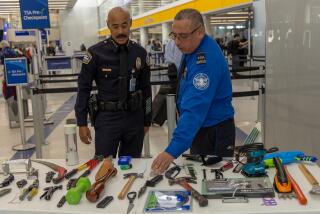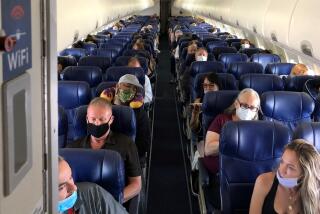TSA asked to reconsider its move to allow small knives on planes
A move by federal officials to allow passengers to board planes carrying pocket knives has sparked a backlash by airline workers and is sowing confusion among travelers.
The union representing air marshals has joined flight attendants, pilots and airline insurance firms in calling on the Transportation Security Administration to reconsider its decision to relax a list of prohibited carry-on items. More than 12,000 people have signed an online petition urging President Obama to keep knives off planes.
Even airline management has entered the fray. Richard Anderson, chief executive of Delta Air Lines, sent a letter to the agency Friday saying he, too, opposes the policy change.
Allowing small knives will “do little to speed the screening of passengers” and result in “additional risk to our cabin staff and customers,” the letter said.
This week, the TSA said it would allow air travelers to board U.S. aircraft with small folding knives, golf clubs, novelty bats, hockey sticks, lacrosse sticks and pool cues.
The agency said the move, which would take effect April 25, was aimed at freeing up security officials to focus on bigger threats while allowing passengers a bit more freedom.
But for many travelers, the latest change adds to the confusion that has reined at U.S. airports since the 9/11 attacks.
“With these changes, can we now bring hair spray, or is that considered more of a threat than golf clubs?” asked Sue Dessayer Porter, a retired market researcher from Portland, Ore. “I’ve even had mascara taken away. It’s good to relax the rules, but how about some consistency?”
As it is, TSA bins are overflowing with shampoo bottles, toothpaste tubes, toy guns and jugs of booze. At Los Angeles International Airport, screeners fill boxes with about 1,400 pocket knives per month.
The list of banned items — ranging from brass knuckles to drill bits — includes nine categories with more than 70 individual items, and has been expanded and revised several times over the years.
TSA officials say the list is adjusted regularly in response to intelligence about potential terrorist threats. But confusion, the TSA says, cannot be blamed on a lack of information.
The agency distributes pamphlets and news releases and posts signs at airport terminals explaining the list. The federal agency even created a smartphone app that answers the question: “When I fly, can I bring my ___?”
“Some people just don’t know what is prohibited and others just forget and don’t think twice that the ceremonial knife that they used to cut their wedding cake is still a knife,” said TSA spokesman Nico Melendez.
But how do you explain, he said, that 1,800 passengers last year tried to bring guns — loaded and unloaded — into planes?
“Is that an element of confusion, or forgetfulness?” Melendez asked.
One factor in the confusion might be that the list of prohibited items has evolved over the years and includes what passengers say are contradictions.
For example, common lighters were removed from the banned list in 2007 but torch lighters that create super-hot, needle-like flames are still prohibited. Novelty baseball bats under 24 inches will be allowed after April 25 but night sticks are still banned.
Feel free to bring a book of matches into the cabin, but not the kind that you can strike on any surface.
Knitting needles are allowed and so are screwdrivers under 7 inches long, but not ice picks.
Snow globes — the perennial knickknack gift — were pulled off the prohibited list a few months ago, but only if the globe has less than 3.4 ounces of liquid inside. That’s about the size of a tennis ball.
Joni Zuckerbrow-Miller, a healthcare worker from Los Angeles, doesn’t see the logic of the list, particularly the prohibition of yogurt in containers larger than 3.4 ounces.
“We all want to be safe,” she said. “I feel no safer knowing yogurt is banned.”
TSA officials defended the latest change, saying it brings U.S. safety standards in line with international standards. It is also designed to free airport screeners from digging pocket knives out of carry-on bags, giving them more time to look for explosives.
Under the change, folding knives with blades less than 2.36 inches long and half an inch wide will be allowed. Box cutters and other blades are still banned.
The TSA has said that small knives are now less of a threat because of added security measures since 9/11. Those include hardened cockpit doors, self-defense training for flight attendants and an increased number of armed federal marshals and pilots.
But some experts say even small blades pose a huge risk to airline workers and passengers.
“If the TSA policymakers were engaged in close-quarter combat with a psycho wielding a 2-inch blade at 30,000 feet, they might reconsider the foolishness of their decision,” said Jon Adler, president of the Federal Law Enforcement Officers Assn., which represents air marshals.
Adler and representatives for flight attendants and pilots unions said they would ask TSA officials to meet to reconsider the knife policy change. TSA spokesman Melendez said no meetings had been scheduled.
More to Read
Inside the business of entertainment
The Wide Shot brings you news, analysis and insights on everything from streaming wars to production — and what it all means for the future.
You may occasionally receive promotional content from the Los Angeles Times.










